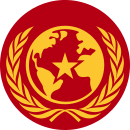More languages
More actions
The Left-Right Political Spectrum is a diagram which is intended to categorise political ideologies in 3 distinct categories: Left Wing, Right Wing and Centrist. The model has received criticism for being idealist, unscientific, subjective, and for ignoring historical materialism and class struggle.
There are successors or variations to the Left-Right Spectrum, one of the most famous successors being the Political Compass. Variations include: the Horseshoe Theory and the Fish hook theory.
History
The terms "Left wing" and "Right wing" derive from the French Revolution, where Bourgeois revolutionaries would sit on the left, whilst those who supported Monarchism sat on the right.
Description
The Model is split into 3 categories (sometimes 2), the left wing, the right wing and the centrists. There can be also prefixes adjoined to the parts of the spectrum as 'far-left' or 'center-right' (not to be confused with centrist), which specify the location within the political spectrum.
Left Wing
Main Article: Left-wing politics
The Left Wing is described is either of two things, depending on what region you live in. In the US, the left wing is described as something who supports more progressive policies such as LGBT rights, and Abortion. In other regions of the world like Europe, the left wing is used to describe those who support either social welfare or anti-capitalist policies.
Right Wing
The Right Wing is usually described as those who oppose progress, and those who support reactionaries. They also typically support less intervention in the government, lower taxes and capitalist policies and economics.
Centrist
Note to be confused with apolitical and moderate, they are typically people who support (and somewhat oppose) both stances, sometimes rejecting one idea of the part over another or choosing neither.
Variations
Horseshoe Theory
Fish Hook Theory
Criticism
Unscientific
The political compass
